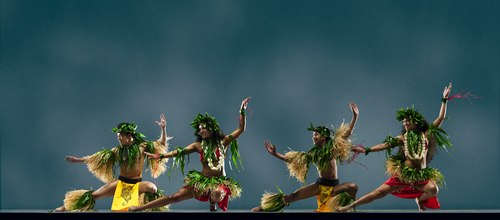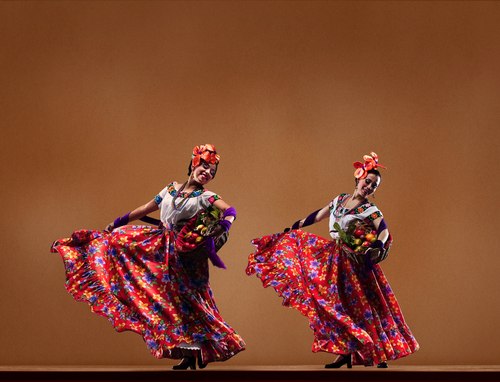|
 |
|
|
 |
 |
San Francisco has a happening dance scene year-round. Come June, when most local companies have hung up their dance shoes for the season, World Arts West presents the annual San Francisco Ethnic Dance Festival. From June 6 to 28, the festival celebrated its thirty first year at the regal Palace of Fine Arts. Each weekend featured a different program with artists from all over Northern California presenting dances from twenty cultures including those from the Congo, the Ukraine, Spain, Peru, Tahiti, Ireland, India, and several others. The first of nine performances on opening night June 6 was by folkloric music and dance troupe Compañia Mazatlán Bellas Artes who performed "Fiesta Tabasquena," a four-part celebratory dance from Tabasco, Mexico. Dancing to live tambore and flute music were nine handsome couples with charming smiles and contagious enthusiasm. The women were radiant with their hair up in flowers and their long flowing skirts with vibrant colors thoroughly dressed up the stage. The men, wearing cowboy hats and boots complimented their female dance partners as they performed with abundant assurance and masculinity. The Spanish influence in their footwork was strikingly distinct and their execution was exceptional. This first performance of the evening was wonderfully uplifting and a genuine display of what the joy of dance is all about. From this year's line-up of youth dancers, one of the most anticipated performances was by ten year-old starlet Athira Pratap. The soloist, trained in Bharata Natyam under the tutelage of choreographer Bindu Pratap, performed the piece "Ohm Kaara," the Eternal Voice — one of many stories of the deities expressed through this exquisite ancient dance form from South India. Upon her entrance, Pratap's potent aura filled the room with positive energy. Wearing an elegant red and gold silk pyjama with bell anklets, she showcased her strong rhythmic sensibility and acute understanding of the Asamyukta Hastas (single hand gestures) and Samayukta Hastas (double hand gestures) — quite admirable for someone her age. Pratap gave a delightful performance that left the audience in awe. The youth dance theme continued with a performance by the Presidio Dance Theatre. The two-part piece, "Ukrainian Suite," began with a traditional line dance led by girls followed by the "Hopak," primarily danced by boys. Former members of the Kirov Ballet designed authentic costumes for the dancers including embroidered dresses and hair garlands with flowers and ribbons for the girls and red Cossack boots and blue satin pants for the boys. The "Hopak," known for its physically demanding feats, was an ambitious piece for the boys to perform, but a good challenge for them to test their skills and athleticism. The dancers were highly enthusiastic and showed good turn out in their feet to maintain their balance during their squatting kicks and they made commendable efforts in their leaps, but several struggled technically. Typically the "Hopak" is performed by men so seeing a few girls perform some simple steps was refreshing. One girl, doing beautiful clean pique turns diagonally across the stage added just the right amount of feminine contrast. Overall, this was a wonderfully entertaining performance, but it did fall short without the accompaniment of a few professional Cossacks. From the Ukraine, we traveled to West Java, Indonesia with dancer Sri Susilowati who performed "Jaipong Tablo," an indigenous Jaipongan dance about a woman in mourning. While a soft silhouette of bamboo trees projected onto the stage background, slow tempo percussion music with metallophones and gongs played, creating a mysterious tropical setting. As she danced barefoot in a long black sarong, Susilowati portrayed her character's sadness convincingly with serious facial expressions, flexed feet and hand gestures that emanated her suffering and longing. Toward the end of the piece, an increase in the music tempo introduced more freedom and variation in her arm movements and steps, and a transformation in her facial expressions that conveyed happier moments between she and her beloved. The energy in the room stepped up a few notches when the Murphy Irish Dancers took the stage next. Over forty dancers from children to adults performed Patricia Feeney-Conefrey's "Tir Na nOg," the Land of the Youth, while five musicians played on stage and nine members of the Bushmill Irish Pipers entered from the audience. Dancing tirelessly in Irish soft shoes with hands upon their waist were twelve teenage girls in short embroidered dresses with sequins showing off their flawless synchronized footwork. Looking dapper in a light blue kilt was one remarkable dancer — seventeen year old Evan Trudell. No one could take their eyes off him as his legs were like those of a marionette. Company founder Mary Jo Murphy-Feeney must have been a fine puppeteer when she primed this young man. More music and dance from Indonesia was presented after intermission; this time by Gamelan Sekar Jaya who performed a traditional dance from Bali. One male and six female dancers performed "Subak," a story of how rice is cultivated. Wonderful flute music with giant bamboo marimbas (xylophones) were played on stage while dancers in stunning long sarongs with gold detail mimed the story. The women were delicate in their appearance showing their bare arms, while the male dancer, performing bare chested, projected a commanding presence. All of their movements were in plié position with feet turned out; and movements with their hands, arms, head, neck, and eyes were fluid and precise, as with all dance forms influenced by the Hindu tradition. From beginning to end, this fascinating theatrical piece was positively divine. Theatre Flamenco added a touch of drama to the evening with the duet "Encuentro," a sensuous piece about a brief love encounter. As the spotlight gradually rose upon cantaor (singer) Felix De Lola while Flamenco guitarist Keni "El Lebrijano" played, a blanket of silence swept across the audience. Dancer Juan Siddi, all dressed in black entered carrying a mantón de Manila (a traditional silk shawl) symbolizing the passionate love between he and his inamorata. Opposite Siddi was artistic director Carola Zertuche portraying his love interest. It was immediately evident that Zertuche and Siddi were well suited for this piece. Both were intense and had similar dance styles and their taconeo (footwork) was very strong. Zertuche's floreo (hand movements) were superb as were Siddi's finger movements, but his wrists seemed over embellished at times, overshadowing and contradicting his gallant demeanor. Near the end, Siddi embraced Zertuche from behind and in perfect unison, the dancers performed quick forceful golpe steps (stamping/striking movements) using only their right feet. In that moment, the dancers ignited the stage with their fiery passion. Next — the show did a full about face with the Barbary Coast Cloggers. Three Appalachian buck-style dances including a circle dance, square dance, and a line dance were performed to country/western and bluegrass music by eight country gents in jeans, cowboy hats, and baseball caps. This particular performance stood apart from the rest partially due to the music styles that were used, but mostly because of the intriguing footwork that incorporates several dance forms such as Irish step-dancing, Dutch clogging, and Cherokee Indian stomping. What's particularly fascinating about clogging is it continues to grow in popularity around the country and as it does, more dance forms such as hip hop are being integrated, keeping this vibrant dance form ever-evolving. Every dancer from this troupe delivered scores of energy, personality, and skill throughout their performance. And when the dancers invited the audience to clap along, everyone was more than happy to oblige. The adrenaline rush ensued with Tahitian dance troupe Te Mana O Te Ra. Dancing to the thundering sounds of toere and pahu drums, an eclectic group of talented young men and women performed the piece "Tani e Pahu," a dance about love in all its manifestations. The stage was a Polynesian feast for the eyes with vegetal costumes made-up of ginger and plumeria lei's, ti leaf head-pieces, and yards of raffia skirts. Watching the women dancers while they performed '_te'a (hip isolations) was absolutely spellbinding. The male dancers were also sensational during the popular pa'oti; a scissor movement with the legs performed with bent knees, raised heels, and closed fists. At the finish, the audience gave a roaring applause. Then the music started up again and the dancers led the way from the stage to the lobby for an informal post-show. During the festival's opening weekend, World Arts West presented a satisfying sampling of cultures. Even with nine different performances though, the ninety minute show flew by quickly. Two hours is a standard show length among most audiences and these days, it's important to give patrons ample justification for how their dollars are spent on arts and entertainment. By adding a tenth performance or five more minutes per group piece, the program length would be right up to par. There was also some imbalance in the program by having two Indonesian dance performances instead of one. It seems that there were more than enough cultures represented throughout the month of June to feature just one other dance form in that first program. World Arts West also had good intentions giving more youth dancers an opportunity to perform this year, but since the annual event has such a strong reputation for excellence, devoting nearly half the program to student performance hinted community theatre. Dance troupes like Te Mana O Te Ra and the Murphy Irish Dancers were among those who featured several youth dancers in their performances, but because they also presented highly skilled dancers, their presentations were more well rounded. As with every past Ethnic Dance Festival, the 2009 season offered many fresh and exciting performance elements. As for 2010, many more intriguing surprises are in store. Among them — a documentary film about the event that will feature stage footage and interviews with many festival artists.
 Te Mana O Te Ra Photo © & courtesy of RJ Muna |
|
 Athira Pratap Photo © & courtesy of RJ Muna |
|
 Gamelan Sekar Jaya Photo © & courtesy of RJ Muna |
|
 Compañia Mazatlán Bellas Artes Photo © & courtesy of RJ Muna |
|
|
|





